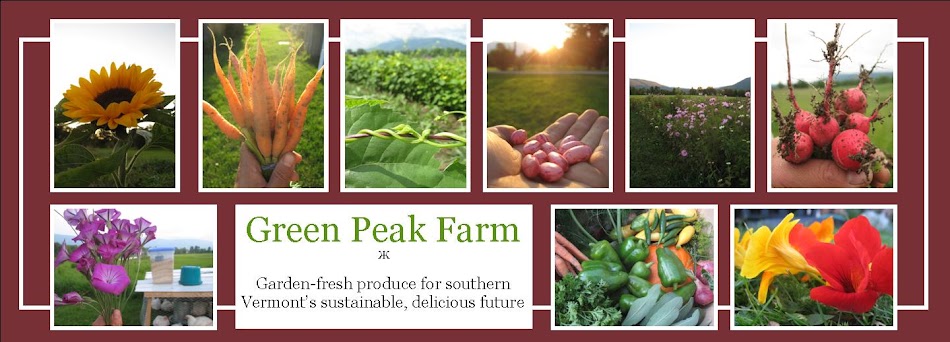 2 lb Kennebec potatoes
2 lb Kennebec potatoes
garlic head
shallots
green onions
1.5 lbs green and purple beans
bag mustard greens
bunch swiss chard
bunch beet greens
1 head green cabbage
2 carrots - mixed colors
summer squash and zukes
picklers and slicing cukes
broccoli side shoots/raab
big bag of basil (1/4 lb)
and FINALLY! the first tiny handfull of tomatoes
 Herbs: thai basil, lemon basil, LOTS of dill, parsley seeds, coriander seeds
Herbs: thai basil, lemon basil, LOTS of dill, parsley seeds, coriander seeds
Flowers: LOTS of sunflowers, celosia, copper amaranth, scabiosa (pincushion flower). Too wet Tuesday to get into the zinnias, but they'll likely be back for Thursday's shares.
 Thankfully, after two days of steady, soaking rain the sun emerged this afternoon to dry out the beans to get in for harvest. Beans are one crop in particular that do not like being handled while wet, as it makes them extremely susceptible to spreading disease. You can expect 1.5-2 lbs of green and purple beans weekly for the next several weeks. If it's too many beans for your liking all at once, you can always blanche them and freeze them for a winter day. They hold beautifully in the freezer-- or make a bean casserole and freeze it up, too!
Thankfully, after two days of steady, soaking rain the sun emerged this afternoon to dry out the beans to get in for harvest. Beans are one crop in particular that do not like being handled while wet, as it makes them extremely susceptible to spreading disease. You can expect 1.5-2 lbs of green and purple beans weekly for the next several weeks. If it's too many beans for your liking all at once, you can always blanche them and freeze them for a winter day. They hold beautifully in the freezer-- or make a bean casserole and freeze it up, too!
 Cukes and zukes are just beginning to taper down from their summer frenzy as the cooler nights help foster the season-ending, somewhat inevitable powdery mildew. You'll likely see them through to the end of your shares, just in lesser quantities.
Cukes and zukes are just beginning to taper down from their summer frenzy as the cooler nights help foster the season-ending, somewhat inevitable powdery mildew. You'll likely see them through to the end of your shares, just in lesser quantities.The first long-anticipated tomatoes are finally coming in after a series of false starts and some ferocious tobacco hornworms. Interestingly, tomato and tobacco (Simpsons, anyone? Tomaco plants...?) are closely related, and on big tomato farms smoking is distinctly prohibited. Disease spreads easily from the smoke and residual oils from tobacco on smokers' hands, and it somehow foils tomato growth.
Anyway, these tobacco hornworms (manduca sexta, which unfortunately is not as fun to write or say as their close relatives, tomato hornworms, or manduca quinquemaculata) are simply put, gross. Anyone who knows me can attest that I am not a squeamish person. However, these suckers make my guts churn, and to me, killing them is gory, nasty business. And the gore is a deep, deep green. The worms themselves are huge, roughly the diameter of a man's pointer finger when mature, and their path of destruction is terrific. They maintain fantastic camouflage and are somewhat hard to spot save two tell-tale signs; they are equally identifiable for the destruction they wreak on the plants and their large, segmented fecal excretions. When the wind stops blowing in the hoophouse, they're large enough that you can HEAR their mandibles chewing tomato plants.
Hornworms are fairly avoidable in that the pupae overwinter in soils, and are often killed during annual tillage-- unless, of course, you're hand-building beds with a bedfork inside a makeshift hoophouse... It's a good lesson to me that next year, yes, I'll wreck the tiller around inside the house a bit before transplanting in the tomatoes, carbon monoxide poisoning be damned. After all, carbon monoxide poisoning is a plant's dream come true; the whole time I was tilling inside the greenhouse, anyway, I was laughing about the passed trend of "oxygen bars". Whatever happened to them, anyway?
And so, tomatoes this week. It's been a bit of a saga, in an ongoing struggle for tomatoes at GPF; I'd like to think I'm getting smarter, but. Bell peppers will be in your share next week.
There is a lot of basil. It is so incredibly happy inside the hoophouse-- the vigor is really incredible. If you've got any big plans for thai or lemon basil, please let me know and I'd be happy to harvest pounds of it for you (pounds is roughly a garbage bag full!)
Please be sure, especially Tuesday folks, to give your produce an extra rinse this week. Because of all that rain, there was quite a bit of mud during harvest. Your mustard greens in particular would benefit from one extra run through the salad spinner.
Please be sure, especially Tuesday folks, to give your produce an extra rinse this week. Because of all that rain, there was quite a bit of mud during harvest. Your mustard greens in particular would benefit from one extra run through the salad spinner.
Beet greens are the equivalent of swiss chard. Did you know that the Chenopod family, which includes beets, chard, and spinach also includes the miracle grain, Quinoa? Fun fact.
Looking ahead: expect more cabbage, fresh onions, more mustard greens, lettuce, and some fresh shelling beans for next week. Also, more toms and a pepper or two. I will be back to school starting Tuesday, so there's a slim chance I may be a bit late in getting the shares organized in the coming weeks. I will do my best to let you know in advance, and I deeply appreciate your patience. Thank you and have a great week!

No comments:
Post a Comment